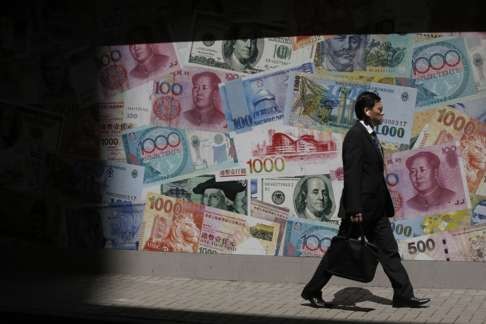Mainland exposure of HK banks at manageable levels
Slowing Chinese economy crimping appetite for mainland lending, say industry experts

Hong Kong accounts for nearly half of foreign banks’ claims on mainland China. While, this means that the city’s banks would be vulnerable to a sudden deceleration or hard landing on the mainland and their balance sheets would suffer, it would take an economic collapse across the border of major proportions for Hong Kong’s banking system to be fundamentally threatened, said industry experts.
Lending by Hong Kong banks to mainland China declined for the first time in a decade last year. By the end of 2015, total exposure to the to the mainland for Hong Kong banks consisted of 27.3 per cent of the total lending by Hong Kong banks, down from 32.8 per cent at the end of 2014, according to figures from global ratings agency Fitch Ratings.
“The fall has happened because of both supply and demand,” said Sabine Bauer, senior director of financial institutions for Fitch Ratings in Hong Kong. “Last year, Hong Kong banks became more concerned about lending to companies on the mainland, while the companies themselves chose to borrow less.”
This marks something of a turnaround. Back in 2006, Hong Kong banks exposure to the mainland’s non banking sector was just 6.6 per cent of their total. In the last decade, opportunities to lend to corporates, particularly state-owned firms, rose as the growing Chinese economy provided the banks with huge opportunities for growth.
“The increase in mainland Chinese exposure since 2006 was natural given the developing economic relationship between the mainland and Hong Kong,” said Chris Leung , senior economist for group research at DBS Bank in Hong Kong.
“However, if the economy in China continues its current deceleration it will cause problems for Hong Kong lenders. If the economy goes down, then inevitably the number of non performing loans will go up.
Tom Fyfe a partner at law firm Simmons & Simmons in Hong Kong said: “There is a lot of bad corporate debt in China. So, as that washes out, as it has to eventually in order to rebuild investor confidence, there will be liquidations (corporate bankruptcies). To that extent Hong Kong banks have direct exposure on their lending books and they will obviously get hit if they have not taken the write-downs already.”
Rising systemic leverage and weakening credit conditions prompted global ratings agency Moody’s Investors Service to cut their outlook for the mainland’s banking sector in March this year. “Growing leverage is making China’s corporate sector more vulnerable to potential shocks. Hence the quality of assets on the books of Chinese banks’ is deteriorating,” said Liu Mingyan, associate managing director of the financial institutions group at Moody’s Investors Service .
“The direct impact [on Hong Kong banks] of a rise in defaults and a hard landing on the mainland is of course subject to each bank’s respective exposure to the mainland,” said Thomas Dillenseger, senior director of Alvarez & Marsal, a professional services firm, in Hong Kong “However, the results of recent stress tests suggest that Hong Kong banks are well prepared for such an event,” he said.
One such stress test was carried out by Fitch, which also identified some banks that it said were more vulnerable to a slowdown on the mainland. “Chinese bank subsidiaries, as well as Bank of East Asia, have the largest share of impairments coming from mainland China exposure, due to their close business collaboration with their parents and the resulting high asset concentrations in mainland-related lending,” the test said.
A spokesperson for BEA said: “In view of the current economic slowdown on the mainland, we are proactively ensuring we address the changing market environment and have adopted a prudent approach to lending by focusing on large state-owned enterprises and customers with higher credit ratings and tightened credit guidelines.”

Leung from DBS said that it is important to distinguish between the different types of state firms when it comes to assessing the risks to the system. “SOEs in sectors where there is significant overcapacity, like steel for example, are the most vulnerable to defaults,” he said.
“Hong Kong banks, however, are not so stupid as to have lent heavily in those sectors.”
In fact, even though exposure to the mainland makes up a little under a third of Hong Kong banks’ total lending, from the mainland perspective of overseas lending is still comparatively small.
Michael Taylor, chief credit officer at Moody’s Investors Service said: “Most of the debt accumulation in China has been domestically funded. As the government is on both sides of these transactions – lending through the state owned banks, and borrowing through the SOEs, we don’t see this rise in leverage necessarily leading to a rise in financial dislocation in the near term.”
Most of the lending by Hong Kong banks has been towards the safer end of the spectrum. “When broken down by the borrowers, Hong Kong banks’ mainland China exposure is mostly to state-owned entities (42 per cent of non-bank loans) and non-mainland entities (38 per cent) operating in China,” said Fitch’s Bauer, adding that the scenario is changing..
“Fitch expects lending to onshore Chinese borrowers to increase as banks, including HSBC, focus on that segment for expansion. Lending to private enterprises – if they pick the better managed and better performing ones, could support banks’ loan quality,” Bauer said.

“Despite the short-term volatilities, we are confident in China’s long-term growth prospects.” said a BEA spokeswoman.
It does appear, however, that since Hong Kong banks’ exposure to the mainland dropped last year, many banks see these opportunities as being smaller than they were.
Nonetheless, even if a major slowdown on the mainland should occur, Fitch’s assessment is that the systemic stability of Hong Kong’s banking system would remain. In their recent stress test, Fitch explored two scenarios. In the more extreme one, which Bauer described, as “not what we expect to happen” they modelled the impact on banks in Hong Kong if they had non performing loan ratios of 7.5 per cent for Chinese state-owned enterprises, 8 per cent for non-mainland entities on the mainland, 20 per cent to private mainland borrowers and 5 per cent for claims on Chinese banks.
Even under this extreme scenario however, “all banks, except for BEA, are likely to maintain their capital level above the minimum regulatory requirements,” according to the test findings.
“Hong Kong banks are well prepared to withstand challenges from a downturn in the credit cycle due to their sound capital position and earnings buffers,” it said.